
Concept explainers
(a)
Interpretation:
It is to be determined whether each of the following syntheses requires a reaction that alters the carbon skeleton.
Concept introduction:
Chemical syntheses are carries out by transforming one
Answer to Problem 13.29P
This chemical synthesis does require a reaction that alters the carbon skeleton because a carbon-carbon
Explanation of Solution
The given chemical synthesis is
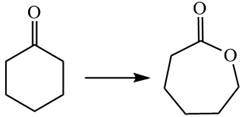
The starting compound is a six carbons ring whereas the product is a seven membered ring with one oxygen atom. Thus, the arrangement of carbon atoms in the product has changed by breaking the carbon-carbon
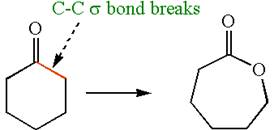
Therefore, this transformation requires a reaction that alters the carbon skeleton.
It is determined that the synthesis requires a reaction that alters the carbon skeleton based on the change in the arrangement of carbon atoms.
(b)
Interpretation:
It is to be determined whether each of the following syntheses requires a reaction that alters the carbon skeleton.
Concept introduction:
Chemical syntheses are carries out by transforming one functional group to another. If the bonding arrangement of carbon atoms remains the same in the product formed, that means the synthesis does not require a change in the carbon skeleton. If it is changed, that means the synthesis requires a change in the carbon skeleton. The forming or breaking of carbon-carbon
Answer to Problem 13.29P
This chemical synthesis does not require a reaction that alters the carbon skeleton as there is no need to break or form a carbon-carbon
Explanation of Solution
The given chemical synthesis is

The starting compound is an alcohol, and the product is ether. The transformation occurs by replacement of the hydrogen attached to oxygen by the isopropyl group, which requires breaking of
It is determined that the synthesis does not require a reaction that alters the carbon skeleton based on the retention of the arrangement of carbon atoms.
(c)
Interpretation:
It is to be determined whether each of the following syntheses requires a reaction that alters the carbon skeleton.
Concept introduction:
Chemical syntheses are carries out by transforming one functional group to another. If the bonding arrangement of carbon atoms remains the same in the product formed, that means the synthesis does not require a change in the carbon skeleton. If it is changed, that means the synthesis requires a change in the carbon skeleton. The forming or breaking of carbon-carbon
Answer to Problem 13.29P
This chemical synthesis does require a reaction that alters the carbon skeleton because a carbon-carbon
Explanation of Solution
The given chemical synthesis is

In this chemical synthesis, the

It means there is a formation of carbon-carbon
It is determined that the synthesis requires a reaction that alters the carbon skeleton based on the change in the arrangement of carbon atoms.
(d)
Interpretation:
It is to be determined whether each of the following syntheses requires a reaction that alters the carbon skeleton.
Concept introduction:
Chemical syntheses are carries out by transforming one functional group to another. If the bonding arrangement of carbon atoms remains the same in the product formed, that means the synthesis does not require a change in the carbon skeleton. If it is changed, that means the synthesis requires a change in the carbon skeleton. The forming or breaking of carbon-carbon
Answer to Problem 13.29P
This chemical synthesis does not require a reaction that alters the carbon skeleton because carbon-carbon
Explanation of Solution
The given chemical synthesis is

The starting compound is an
It is determined that the synthesis does not require a reaction that alters the carbon skeleton based on the retention of arrangement of carbon atoms.
(e)
Interpretation:
It is to be determined whether each of the following syntheses requires a reaction that alters the carbon skeleton.
Concept introduction:
Chemical syntheses are carries out by transforming one functional group to another. If the bonding arrangement of carbon atoms remains the same in the product formed, that means the synthesis does not require a change in the carbon skeleton. If it is changed, that means the synthesis requires a change in the carbon skeleton. The forming or breaking of carbon-carbon
Answer to Problem 13.29P
This chemical synthesis does require a reaction that alters the carbon skeleton because a carbon-carbon
Explanation of Solution
The given chemical synthesis is
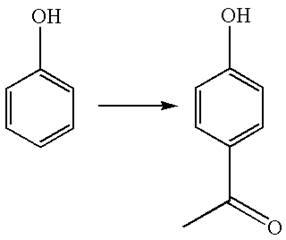
In this chemical synthesis, the hydrogen atom of benzene is replaced by the acetyl group,
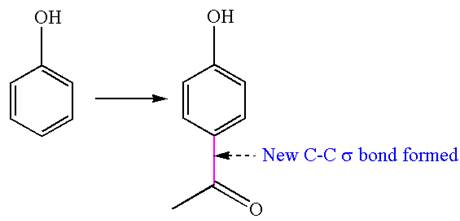
Therefore, this synthesis requires a reaction that alters the carbon skeleton.
It is determined that the synthesis requires a reaction that alters the carbon skeleton based on the change in the arrangement of carbon atoms.
(f)
Interpretation:
It is to be determined whether each of the following syntheses requires a reaction that alters the carbon skeleton.
Concept introduction:
Chemical syntheses are carries out by transforming one functional group to another. If the bonding arrangement of carbon atoms remains the same in the product formed, that means the synthesis does not require a change in the carbon skeleton. If it is changed, that means the synthesis requires a change in the carbon skeleton. The forming or breaking of carbon-carbon
Answer to Problem 13.29P
This chemical synthesis does require a reaction that alters the carbon skeleton because a carbon-carbon
Explanation of Solution
The given chemical synthesis is

The starting compound has a five carbons ring with double bond, and the product has a five carbons ring fused with a three-membered ring. This could occur by breaking of carbon-carbon

Therefore, this synthesis requires a reaction that alters the carbon skeleton.
It is determined that the synthesis requires a reaction that alters the carbon skeleton based on the change in arrangement of carbon atoms.
(g)
Interpretation:
This chemical synthesis does require a reaction that alters the carbon skeleton because a carbon-carbon
Concept introduction:
Chemical syntheses are carries out by transforming one functional group to another. If the bonding arrangement of carbon atoms remains the same in the product formed, that means the synthesis does not require a change in the carbon skeleton. If it is changed, that means the synthesis requires a change in the carbon skeleton. The forming or breaking of carbon-carbon
Answer to Problem 13.29P
No, this chemical synthesis does not require a reaction that alters the carbon skeleton because carbon-carbon
Explanation of Solution
The given chemical synthesis is

The starting compound is an alkene, and the product is
It is determined that the synthesis does not require a reaction that alters the carbon skeleton based on the retention of arrangement of carbon atoms.
(h)
Interpretation:
It is to be determined whether each of the following syntheses requires a reaction that alters the carbon skeleton.
Concept introduction:
Chemical syntheses are carries out by transforming one functional group to another. If the bonding arrangement of carbon atoms remains the same in the product formed, that means the synthesis does not require a change in the carbon skeleton. If it is changed, that means the synthesis requires a change in the carbon skeleton. The forming or breaking of carbon-carbon
Answer to Problem 13.29P
This chemical synthesis does require a reaction that alters the carbon skeleton because a carbon-carbon
Explanation of Solution
The given chemical synthesis is

The starting compound has a five carbons chain with two conjugated double bonds, and the product has a six carbons ring fused. This could occur by breaking of carbon-carbon
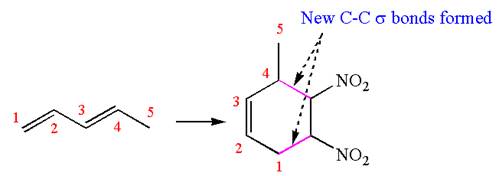
Therefore, this synthesis requires a reaction that alters the carbon skeleton.
It is determined whether the synthesis requires a reaction that alters the carbon skeleton based on the change in the arrangement of carbon atoms.
Want to see more full solutions like this?
Chapter 13 Solutions
Get Ready for Organic Chemistry
- 11 Organic Chemistry Organic Nomenclature Practice Name/Functional Group n-butane Formula Structural Formula (1) C4tt10 H3C C- (2) CH3CH2CH2 CH 3 H₂ -CH3 Н2 name & functional group (1) and (2) OH H₁₂C Н2 name only (1) and (2) name only (1) and (2) H₁C - = - CH₂ Н2 HC=C-C CH3arrow_forwardUnder aqueous basic conditions, nitriles will react to form a neutral organic intermediate 1 that has an N atom in it first, and then they will continue to react to form the final product 2: NC H₂O он- H₂O 1 2 OH Draw the missing intermediate 1 and the final product 2 in the box below. You can draw the two structures in any arrangement you like. Click and drag to start drawing a structure.arrow_forwardAssign these COSY Spectrumarrow_forward
- Assign these C-NMR and H-NMR Spectrumarrow_forwardPredict the product of this organic reaction: IZ + HO i P+H₂O Specifically, in the drawing area below draw the skeletal ("line") structure of P. If there is no reasonable possibility for P, check the No answer box under the drawing area. No Answer Click and drag to start drawing a structure. ☐ :arrow_forwardPredict the products of this organic reaction: 0 O ----- A + KOH ? CH3-CH2-C-O-CH2-C-CH3 Specifically, in the drawing area below draw the condensed structure of the product, or products, of this reaction. (If there's more than one product, draw them in any arrangement you like, so long as they aren't touching.) If there aren't any products because this reaction won't happen, check the No reaction box under the drawing area. No reaction Click anywhere to draw the first atom of your structure. X ⑤ èarrow_forward
- Predict the products of this organic reaction: O CH3 + H2O + HCI A A? CH3-CH2-C-N-CH3 Specifically, in the drawing area below draw the condensed structure of the product, or products, of this reaction. If there's more than one product, draw them in any arrangement you like, so long as they aren't touching. If there aren't any products because this reaction won't happen, check the No reaction box under the drawing area. No Reaction Click anywhere to draw the first atom of your structure.arrow_forwardWhat is the missing reactant in this organic reaction? R+ HO-C-CH2-CH3 0= CH3 CH3 —CH, C−NH—CH CH3 + H₂O Specifically, in the drawing area below draw the condensed structure of R. If there is more than one reasonable answer, you can draw any one of them. If there is no reasonable answer, check the No answer box under the drawing area. Note for advanced students: you may assume no products other than those shown above are formed. No Answer Click anywhere to draw the first atom of your structure. €arrow_forward个 CHEM&131 9267 - $25 - Intro to Mail - Hutchison, Allison (Student x Aktiv Learnin https://app.aktiv.com Draw the product of the reaction shown below. Ignore inorganic byproducts. + Na2Cr2O7 Acetone, H2SO4 Type here to search Dryng OH W Prarrow_forward
- Predict the products of this organic reaction: OH + NaOH A? Specifically, in the drawing area below draw the skeletal ("line") structure of the product, or products, of this reaction. (If there's more than one product, draw them in any arrangement you like, so long as they aren't touching.) If there aren't any products because this reaction won't happen, check the No reaction box under the drawing area. No reaction Click and drag to start drawing a structure. ✓ Sarrow_forwardPredict the products of this organic reaction: CH3-C-O-CH2-CH2-C-CH3 + H₂O ? A Specifically, in the drawing area below draw the condensed structure of the product, or products, of this reaction. (If there's more than one product, draw them in any arrangement you like, so long as they aren't touching.) If there aren't any products because this reaction won't happen, check the No reaction box under the drawing area. No reaction Click anywhere to draw the first atom of your structure. :☐ darrow_forwardDE d. Draw an arrow pushing mechanism for the following IN O CI N fo 人 P Polle DELL prt sc home end ins F5 F6 F7 F8 F9 F10 F11 F12arrow_forward
 Organic Chemistry: A Guided InquiryChemistryISBN:9780618974122Author:Andrei StraumanisPublisher:Cengage Learning
Organic Chemistry: A Guided InquiryChemistryISBN:9780618974122Author:Andrei StraumanisPublisher:Cengage Learning Chemistry for Today: General, Organic, and Bioche...ChemistryISBN:9781305960060Author:Spencer L. Seager, Michael R. Slabaugh, Maren S. HansenPublisher:Cengage Learning
Chemistry for Today: General, Organic, and Bioche...ChemistryISBN:9781305960060Author:Spencer L. Seager, Michael R. Slabaugh, Maren S. HansenPublisher:Cengage Learning World of Chemistry, 3rd editionChemistryISBN:9781133109655Author:Steven S. Zumdahl, Susan L. Zumdahl, Donald J. DeCostePublisher:Brooks / Cole / Cengage Learning
World of Chemistry, 3rd editionChemistryISBN:9781133109655Author:Steven S. Zumdahl, Susan L. Zumdahl, Donald J. DeCostePublisher:Brooks / Cole / Cengage Learning


